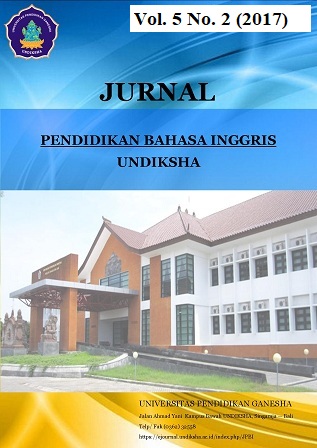APOLOGY ACTS AMONG EFL STUDENTS AT SEKOLAH MENENGAH ATAS NEGERI 1 BATURITI
DOI:
https://doi.org/10.23887/jpbi.v5i2.15168Abstract
Penelitian ini bertujuan untuk 1) menguji bentuk-bentuk dari tindak lokusi dan perlokusi permintaan maaf dan menginvestigasi strategi-strategi tindak lokusi dan perlokusi permintaan maaf yang digunakan oleh siswa Sekolah Menengah Atas (SMA) Negeri 1 Baturiti. Penelitian in merupakan penelitian deskriptif qualitatif yang mana data dikumpulkan berupa kalimat. Subjek dari penelitian ini adalah 30 orang siswa kelas sebelas di SMA Negeri 1 Baturiti. Data dikumpulkan pengamatan. Data yang didapatkan dianalisis menggunakan teori dari Nordquist (2018) tentang bentuk (struktur kalimat dan tipe kalimat), teori dari Cohen & Olshtain’s (1983) tentang strategi tindak lokusi (permintaan maaf langsung dan tidak langsung) dan teori dari Holmes (1995) tentang strategy merespon permintaan maaf. Hasil penelitian menunjukkan bahwa bentuk-bentuk tindak lokusi permintaan maaf siswa yang paling sering digunakan adalah kalimat sederhana dan kalimat positif, sedangkan tindak perlokusi permintaan maaf yang yang paling sering digunakan oleh siswa adalah kalimat sederhana dan kalimat positif. Dalam strategi tindak lokusi permintaan maaf, siswa paling sering menggunakan permintaan maaf secara langsung. Sedangkan, dalam strategi tindak perlokusi, siswa paling sering mengunakan menerima dan memberi jawaban ambigu. Namun tidak ada satupun siswa yang menggunakan penolakan dalam merespon permintaan maaf.Kata Kunci : bentuk, permintaan maaf, strategi, tindak lokusi dan perlokusi
This study aimed to 1) examine the locutionary and perlocutionary acts forms of apology and 2) investigated the locutionary and perlocutionary acts strategies of apology used by the students of Sekolah Menengah Atas (SMA) Negeri 1 Baturiti. This study was descriptive qualitative research which data were collected in the form of sentences. The subject of this research was 30 in eleventh grade students of SMA Negeri 1 Baturiti. The data were collected by observing. The data was analyzed by using Nordquists (2018) theory about form (sentence structure and sentence type), Cohen & Olshtain’s (1983) theory about locutionary acts strategy (direct and indirect apoloy) and Holmes’ (1995) theory about responding strategy. The finding shows that students’ locutionary acts forms of apology were frequently using simple and positive sentences, meanwhile the perlocutionary acts forms of apology were also frequently using simple and positive sentences. In addition, the most frequently used strategy by the students was direct apology in locutionary acts. Meanwhile, the most frequently used strategy by students was accept and evade in perlocutionary acts. However there was no one of the students used reject in responding an apology.
keyword : apology, form, locutionary and perlocutionary acts, strategy
Published
2018-07-26
Issue
Section
Articles
License
Authors who publish with the Jurnal Pendidikan Bahasa Inggris Undiksha agree to the following terms:- Authors retain copyright and grant the journal the right of first publication with the work simultaneously licensed under a Creative Commons Attribution License (CC BY-SA 4.0) that allows others to share the work with an acknowledgment of the work's authorship and initial publication in this journal
- Authors are able to enter into separate, additional contractual arrangements for the non-exclusive distribution of the journal's published version of the work (e.g., post it to an institutional repository or publish it in a book), with an acknowledgment of its initial publication in this journal.
- Authors are permitted and encouraged to post their work online (e.g., in institutional repositories or on their website) prior to and during the submission process, as it can lead to productive exchanges, as well as earlier and greater citation of published work. (See The Effect of Open Access)













